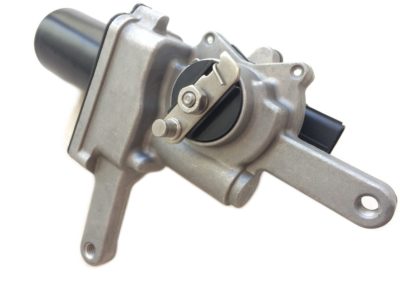Turbocharger Electronic Actuator Stepper Motor Information
Stepper Motor Actuators & Turbochargers

A Turbocharger Electronic Stepper Motor Actuator, moves the vanes inside a VNT (Variable Nozzle Technology) turbo.
Variable vanes do the same job as a dump valve on a standard (non-VNT) pneumatic-actuated turbo.
That is, they allow boost to build and dump, by hold or release of gasses.
The vanes move inside the VNT Assembly, itself installed inside the Turbine (hot or exhaust end) housing.
The open & closing vane movements, are facilitated by circular motion of the VNT Assembly Nozzle Ring.
But the Actuator only moves (actuates) an ‘Arm’ in a linear motion.
So that linear motion needs to be converted to a circular left-to-right motion in the Nozzle Ring.
And a lever connecting the actuator arm to the Nozzle Ring does just that.
Why ‘Calibration’ of the Stepper Motor Actuator is Sometimes Required
We supply both Stepper Motor Actuators and Turbochargers.
We sell the separate actuator component, to fix a problem associated with actuation of the turbocharger VNT assembly.
But we also offer complete turbochargers, where the actuator comes attached to the turbo, with both being flow-tested at the factory.
Flow testing calibrates the stepper motor to a range of movement under factory standard parameters.
Providing correct vane actuation for the rev range.
Installing a new Turbocharger Electronic Actuator Stepper Motor (where the component is purchased separately), usually involves only 3 bolts.
Additionally, the actuator arm is attached via a clip to the actuator.
And the other end of the arm attaches via another clip to the lever that actuates (moves) the vanes inside the turbo.
Once the turbocharger electronic actuator stepper motor is attached to the turbo, it should work immediately with very little adjustment.
But, in some cases, a ‘calibration’ may be required.
Typical cases where calibration is likely required include (but not limited to):
– A fault code relating to stepper motor that persists once code has been cleared, and the code persists even after the new actuator has been installed.
(An example code would be: P0047 which relates to stepper motor. This may indicate low voltage or out of range boost pressure detected).
– Or cases where insufficient boost has been attained or general over-boost fault codes are thrown by the ECU.
(And includes cases where the vehicle goes into ‘limp’ mode to protect engine components).
– Where there are ‘mods’ on the engine systems such as induction, ECU and/or exhaust (especially in cases where an EGR has been ‘blanked’ off.
Modifications such as those above, create a modified operating environment, so factory parameters become less relevant.
Stepper Motors & Fault Codes
Because of the general nature of fault codes, they can seem to emulate the same issue as the original fault that indicated actuator replacement.
But codes usually lump 2 or more different issues under the same fault code.
Another example is where the problem exists outside of the turbo/actuator system.
The fault may be a wiring or actuator control module problem.
Or in other engine sub-systems such as the exhaust or air intake system.
Click this link for more information on specific Turbocharger Electric Actuator Stepper Motor Fault Codes.
Stepper Motor Calibration
Where mechanical calibration only is required, the essence is as follows:
The stepper motor actuator should be calibrated to create the correct range of movement to fully actuate the vanes.
This will give a correct amount of boost and dump across the rev range, without producing over-boost or under-boost.
This is usually facilitated by adjusting a small stopper screw on the turbo, next to the lever that actuates the vanes.
Stopper adjustments should be made in small increments(of 1/16 of a stopper screw turn), and testing of flow and boost done between adjustments.
What if Stepper Motor Calibration doesn’t work?
Where a fault still exists after the above calibrations have been performed, the following may need to be checked:
– The correct functioning of the actuator control module (if the car has a separate one).
– The correct functioning of the main ECU.
– MAF sensor functioning (will generally show up as a fault code if problematic), but may be worth cleaning with electrical contact cleaner.
– The correct functioning of the EGR Valve, cleaning of which can sometimes help.
– A check done of all fittings, pipes(especially for splits in vacuum lines), gaskets, clamps, air cleaner & snorkel (where fitted).
– A manual check done for free and easy movement of the lever that moves the vanes inside the turbo.
Any stickiness in the lever is usually a fault inside the nozzle / vane system inside the turbocharger turbine housing.
And is usually due to excessive ‘coking’ inside the vane assembly, from incorrect engine combustion.
These are just a few of the main checks that can be done to aid the diagnosis.
And any of the above issues, may show up incorrectly as a stepper motor actuator issue.
A Cautionary Note:
A faulty Turbocharger Electronic Actuator Stepper Motor can eventually create problems inside the turbo and vice versa.
If the ECU is ‘throwing’ codes associated with the turbo or stepper motor actuator, and / or the vehicle is going into limp mode, it is best to tackle the issue early.
By doing so you are helping to keep the issue isolated to either part, so less likely you will need to replace the entire turbocharger system.
As a general recommendation; if there is a chance the actuator may be faulty as well as turbocharger, the turbocharger should replaced.
This will save the time and money involved in replacing the actuator, but the problem is the Turbocharger.
Here is a list of the quality, affordable aftermarket Turbocharger Electronic Actuator Stepper Motors, sold with a 3 Year Warranty.
If you have any other query on matching turbo parts for your vehicle, please feel free to contact our sales support on: 0490 059 316.
